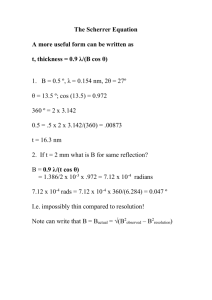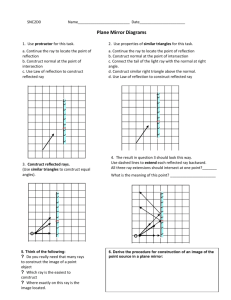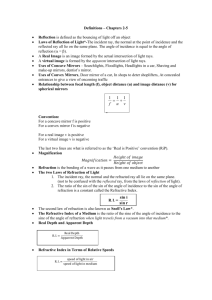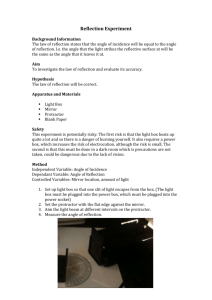LIGHT_Lesson_LAW of RELFECTION
advertisement
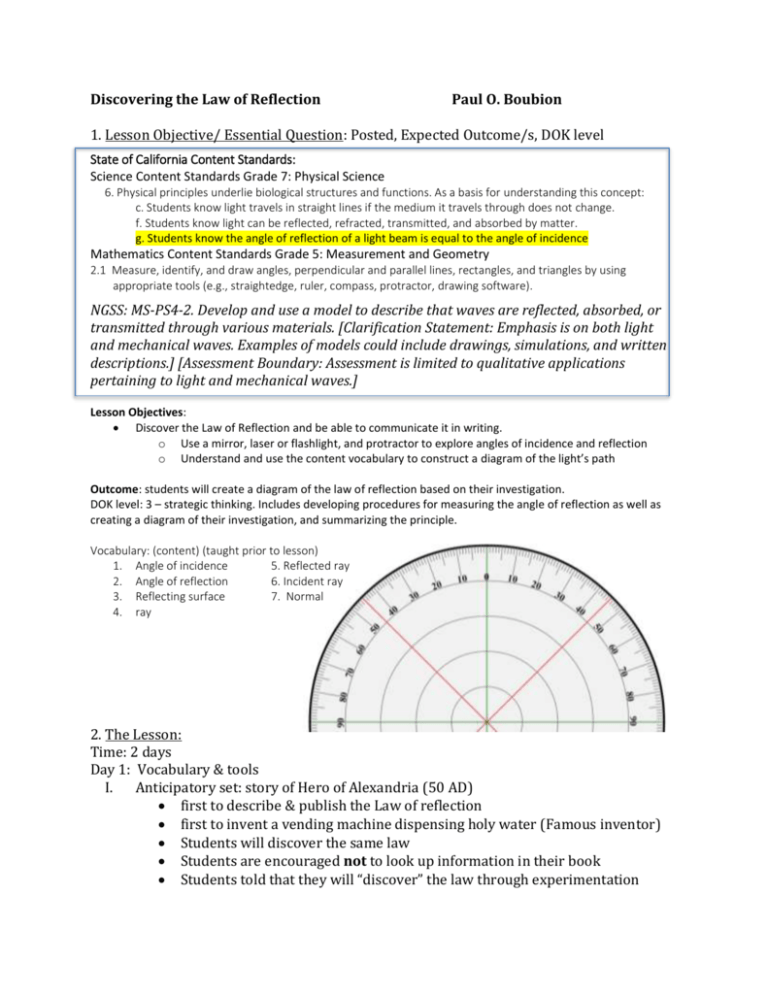
Discovering the Law of Reflection Paul O. Boubion 1. Lesson Objective/ Essential Question: Posted, Expected Outcome/s, DOK level State of California Content Standards: Science Content Standards Grade 7: Physical Science 6. Physical principles underlie biological structures and functions. As a basis for understanding this concept: c. Students know light travels in straight lines if the medium it travels through does not change. f. Students know light can be reflected, refracted, transmitted, and absorbed by matter. g. Students know the angle of reflection of a light beam is equal to the angle of incidence Mathematics Content Standards Grade 5: Measurement and Geometry 2.1 Measure, identify, and draw angles, perpendicular and parallel lines, rectangles, and triangles by using appropriate tools (e.g., straightedge, ruler, compass, protractor, drawing software). NGSS: MS-PS4-2. Develop and use a model to describe that waves are reflected, absorbed, or transmitted through various materials. [Clarification Statement: Emphasis is on both light and mechanical waves. Examples of models could include drawings, simulations, and written descriptions.] [Assessment Boundary: Assessment is limited to qualitative applications pertaining to light and mechanical waves.] Lesson Objectives: Discover the Law of Reflection and be able to communicate it in writing. o Use a mirror, laser or flashlight, and protractor to explore angles of incidence and reflection o Understand and use the content vocabulary to construct a diagram of the light’s path Outcome: students will create a diagram of the law of reflection based on their investigation. DOK level: 3 – strategic thinking. Includes developing procedures for measuring the angle of reflection as well as creating a diagram of their investigation, and summarizing the principle. Vocabulary: (content) (taught prior to lesson) 1. Angle of incidence 5. Reflected ray 2. Angle of reflection 6. Incident ray 3. Reflecting surface 7. Normal 4. ray 2. The Lesson: Time: 2 days Day 1: Vocabulary & tools I. Anticipatory set: story of Hero of Alexandria (50 AD) first to describe & publish the Law of reflection first to invent a vending machine dispensing holy water (Famous inventor) Students will discover the same law Students are encouraged not to look up information in their book Students told that they will “discover” the law through experimentation II. III. IV. V. DI: Vocabulary (see above) a. Teacher polls students for understanding and background knowledge (Kinsella 1-4, scale: 1-no knowledge, 4 – mastery) b. Students copy diagrams with vocabulary into notes c. Teacher reviews norms for behavior Modeling: protractor a. Teacher models protractor use i. Attention given to common errors and setup up the tool ii. Teacher measures an acute and obtuse angles iii. Using Elmo & video projection Guided practice: a. Students create two intersecting lines and measure the resultant angle with their protractor, b. Pairs of students a check each other’s work and results c. Teacher checks EL’s and random students d. Teacher selects student peer tutors to help class Closure a. Teacher summarizes objective for lab day b. Teacher reminds students to complete homework listed on board 2. The Lesson: DAY 2 2.1 Anticipatory Set: (focus learners, state lesson objective/purpose, attach to previous learning) Teacher will review the objectives of the lesson: Explore the reflection of light off of a mirror Create an experiment to discover the angle of incidence and angle of reflection Draw a diagram of your experiment labeling elements with appropriate vocabulary (in your notes) Summarize your findings (in your notes ) Be prepared to present your diagram showing the law of reflection (extension) Teacher will review the content vocabulary from the previous day. 2.2 Instruction Review the vocabulary of the unit. Refer to the previous day’s notes & diagrams. Poll students or ask questions to check for understanding. 3. Modeling: (teacher demonstration, examples, multiple modalities) Show students the general setup of the mirror, light and paper protractor. Place mirror on the table, place something under the mirror to raise it level with the protractor. (don’t turn on the light, so students can for themselves) Suggest students improve on the teacher’s model. Try several setups. Discuss and check for understanding. Discuss care and clean up protocol. Pass out materials. 4. Check for Understanding: (questions, equity system, discussion/feedback, student engagement) Seating chart, equity cards w/ELL & IEP notations. English 3D – vocabulary polling (show 1 finger if you don’t understand, 2,3, etc.) Pair – share. Sample questions: Did you guess where ray of reflection would be ? What is the role of the mirror? Use your finger to show the angle of incidence…. reflection… normal line…. Use the vocabulary to explain what you learned today. 5. Guided Practice: (work accomplished during the lesson with feedback) Remind students that the goal is to discover the law of reflection. Suggest students use a paper target to catch the ray of reflection. Students may stand the protractor up or lay it down, stand up the mirror or lay it down. Several hands and eyes may be necessary to steady the setup. See CFU for questioning 6. Independent Practice: (next steps, homework assignment) Each student must construct a diagram showing the Law of Reflection using vocabulary labels (interactive notebook) Diagrams should include: o Normal line & mirror surface o Incident ray & reflected ray o Angle of incidence, angle of reflection o Indication of congruent angles Write a summary paragraph of your findings (provide sentence frames as needed) – (here is a scaffolded paragraph) o Ie: My partner and I (experimented, interacted)with light and mirrors. o We shined a (flashlight, laser) onto a mirror and (examined, studied) the way the light (reflected, travelled). o We started by measuring the angle of incidence ( °). We then (measured, observed) that the reflected (ray, beam of light) had an angle of ( °). o The angle of incident (did, did not) equal the angle of reflection. If not, explain what you did next. o We have (discovered, developed, proved) the Law of Reflection. o (In conclusion, Basically) it (states, says) that when a ray of light reflects on a (smooth, straight, mirrored) surface, it will always 7. Lesson Closure: (lesson review with student input) Allow groups to share their findings with neighbors. Review conduct norms. Select four to present their findings to the class using the projection device. Invite questions from students. Final closure: remind students of weekly homework schedule o Remind students that they must have a completed paragraph written in their notes by Friday. o Remind students that all missing notes can be found on Haiku. Sample setup Law of Reflection Lab SAMPLE SUMMARY (scaffolded – for ELL) My partner and I (experimented, interacted) with light and mirrors. We shined a (flashlight, laser) onto a mirror and (examined, studied) the way the light (reflected, travelled). We started by measuring the angle of incidence ( °). We then (measured, observed) that the reflected (ray, beam of light) had an angle of ( °). The angle of incident (did, did not) equal the angle of reflection. If not, explain what you did next. We have (discovered, developed, proved) the Law of Reflection. (In conclusion, Basically), it (states, says) that when a ray of light reflects on a (smooth, straight, mirrored) surface, it will always…


